Victoria National
Indiana, United States of America

The view from the 4th tee captures the rugged feel of Victoria National. The spoils and the lakes that were created from strip mining are all too evident to the golfer.
Terry Friedman, the owner of what would become Victoria National Golf Club, knew what he wanted from the outset: a unique course that would be worthy of national recognition the day it opened and that could host major competitions. While many owners have a similar dream, the difference is that Friedman methodically went about achieving it. First, Friedman scoured the middle regions of the United States looking for unique property. The process was slow and thorough as he appreciated that the site would ultimately dictate a large part of the project’s success. He finally found what he was looking for near Evansville in the southern part of Indiana- a former strip mining operation.
From there, he brought in his friend Tom Fazio and they went to work. As a result of their existing friendship, Fazio devoted plenty of personal, on-site time to this project, something that has been missing. After several first-rate courses from the late 1980s and early 1990s (Wade Hampton, Shadow Creek, the Pine Barrens Course at World Woods), Fazio had become inundated with projects to the point where he couldn’t possibly spend enough time at each site. A direct consequence was that an innovativeness was lost as his projects started to take on a similar feel. While his courses remained artistically appealing, they had lost their edge, with too much emphasis on ‘playability’ and not enough on strategy. Friedman wanted no part in this and clearly stated that he wanted a course that could test the very best, something that Fazio courses haven’t done at the highest national level. With the owner pushing him to make the most of the course’s rugged setting, Fazio was free to utilize as he best saw fit the deep lakes, ravines and hills that strewn the 400 acre property.

The short 16th offers little room for error and is indicative of the test that Friedman wanted.
Fazio deserves significant credit for his routing, as it seamlessly incorporates the features from the ceased mining activities into the design of the course. Lakes were created in the strip mines when the digging eventually reached underground springs and Fazio uses the water to create a number of interesting playing angles. How much is the golfer willing to bite off on the diagonal carry off the 2nd and 4th tees? Is he willing to throw his approach to the back hole locations on the 9th green, the back of which is surrounded by water? Can the golfer avoid the lake on the left of the one shot 11th by using the right to left slope by the green? Is the golfer willing to flirt with the water on the right of the 17th and 18th in order to have the easiest angle/shot into the respective greens? As for the mounds of the ‘spoils’, they created an interesting proposition to Fazio as they typically run parallel to each other and to the water.
Often, particularly on the front nine, a player might think that the sides of the hole were built up in that artificial and modern hope of separating one hole from another. However, he is wrong. True, those series of mounds are artificial, but they were made decades before the site was ever considered for a golf course. Therefore, Fazio had to work with what, in effect, amounted to rows of dunes. He fitted many holes between the heaps (e.g., the 14th), but some were routed across them (e.g., the 15th). There is the oxymoronic situation of having mounds that are both artificial (man-made) and at the same time natural (pre-existing). At Victoria National, Fazio took the chances that he has avoided in recent times, from tucking the 3rd green between a spoils mound and the water to the fiercely sloping 10th green to the short 16th with no margin for error with water on three sides. The brutal finishing stretch starting with the 14th hole proves that ‘playability’ was not at the forefront of the architect’s mind. However, while the site guaranteed a certain toughness, Fazio continued with his penchant for designing a varied and interesting set of short two-shotters (another notable example being Caves Valley). The 2nd, 4th, and 12th at Victoria National follow suit, with the driveable 12th being in the same mode as the excellent 14th at Lake Nona and the 15th at the Pine Barrens course.
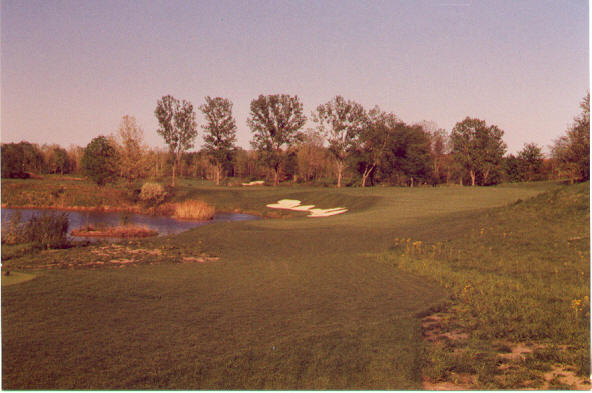
The strong player is tempted to take a crack at driving the 12th green by carrying the visible bunker, catching a downward fairway slope and having his ball bound onto the green, which is open in front.
Another area where Friedman’s influence is felt is that he believes golf is a walking game, and there are numerous trails from green to tee and from tee to fairway that make Victoria National a sheer delight to walk. In addition, Friedman has established a caddie program that the members have embraced.

Little work was required to level this spoil and create what would become the 13th tee.
Holes to Note (All yardages are from the 6,860 set of tees as opposed to the 7,240 set).
Second hole, 355 yards; The first of an admirable group of short two-shotters, the 2nd is the most dramatic with its tee shot across the water to the fairway located atop thefifty foot bluffs on the far side. The tee shot needs to hug the left side to afford the best angle into the green protected by a dominant front-right bunker. A tee shot down the right side leaves it quite difficult to attack a back-right hole location over that bunker and a nervy angle to approach the left side of the green with the water just beyond and left.
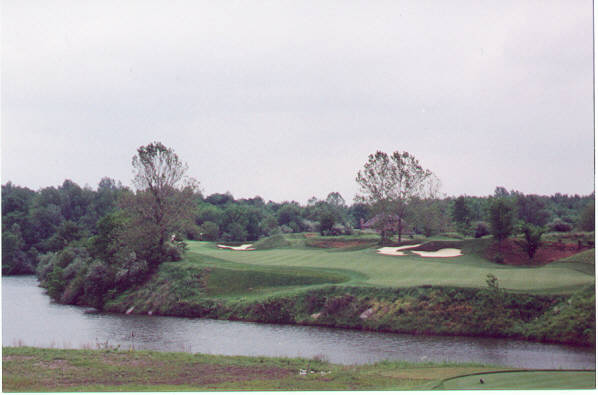
The dramatic and strategic tee shot on the 2nd with a drive down the left rewarding the golfer with a (relatively) straightforward approach shot.
Third hole, 540 yards; The authors’ favorite hole on the course, the 3rd is an original three-shotter where the second shot is the key to the hole, whether the player is going for the green or laying up. After a drive along the bluffs with water on the left, the player needs to place his second shot both long enough and far enough left to give himself a view of the green tucked behind a hill at the corner and the angle to allow him to play down the length of the green and not across it (and toward the water just beyond). Conversely, the Tiger might take a crack at the green in two and to be successful, he must play his approach shot some thirty yards to the left of the green, let it take the slope and trickle down onto the green which runs from front to back. Regardless of the player’s skill level, the hole plays equally well, ands thus is a truly great golf hole.

From behind the 3rd green, the downward slope of the fairway and green is evident, as is the angle of the green to the fairway.
Sixth hole, 430 yards; A bunkerless hole that ends with a green that can beg for a running approach, depending on which tier the hole is located. A fine change of pace hole that adds variety to the overall challenge of the course.
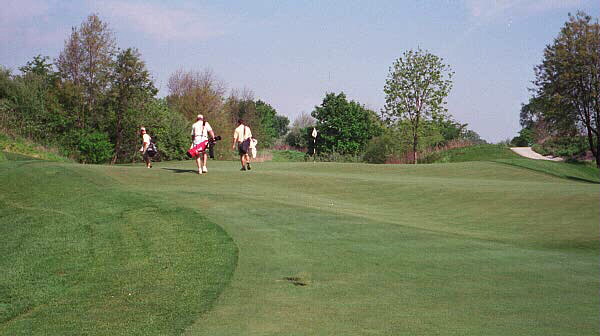
The flagstick is located on the back third tier, access to which is best accomplished by chasing the approach up onto the green.
Ninth hole, 540 yards; An intriguing hole made by the split fairway for the lay-up second shot and an unusual green shape, the 9th lets its hole location dictate the proper play (and the golfer glimpses the day’s hole location as he walks to the 1st tee). When the hole is front right, the player must take the narrower and riskier right side of the fairway for his second to have a reasonable chance to get his third close to the hole. In such circumstances, if the player plays down the wider left side, his pitch must be fitted between the front bunker and the water beyond that shallow part of the green. A rear hole location is also particularly nervy, with the water beyond. It is interesting how trouble beyond a green is often a bigger test of a player’s nerves than trouble short of the target. Fazio also successfully used the split fairway for the second shot on other three-shotters built since Victoria National, namely the 9th hole at Pinehurst No. 4 and the 17th at the University of North Carolina’s new Finley course.

Plenty of options on the split 9th fairway, as seen from the clubhouse.
Fourteenth hole, 445 yards; Along with the 16th, the 14th best illustrates how Fazio delivered the sturdy challenge that Friedman requested. After the forced carry tee shot is negotiated, the player faces an even harder shot: along, uphill approach to a wide but only moderately deep green. In fact, the far left of the green is a mere 13 paces deep.The front left is protected by a huge, rough drop-off while a ball landing in the fairway short and right of the green will often roll back a full 40 yards to the bottom of the hill. This is exactly the type of hole that has been absent from Fazio’s more recent work, as the adjective ‘playable’ never enters the player’s mind as he fights his way to a five (and is quite happy to do so as well).
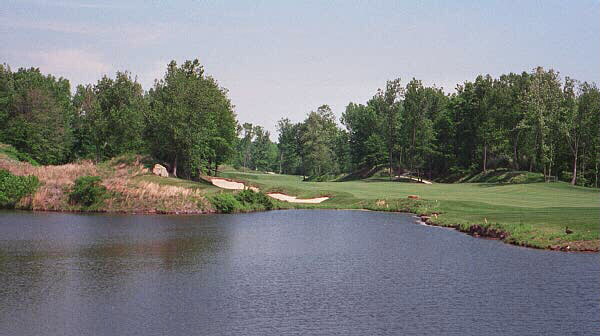
As seen from the 14th tee, the rows of spoils heaps on the left show what the architect faced.
Fifteenth hole, 535 yards; A fine example of how technology won’t obsolete Victoria National’s challenge. Yes, the hole appears reachable in two based on its length and the big hitter delights to find that his tee ball may even gain extra yards from a downslope. The rub is that this downslope plagues the golfer for his approach shot and hitting a wood or long iron from a down slope that must a) carry a lake and b) stop on the green is not exactly the strong suite of many a golfer, despite changes in technology.

J.P. Morgan blasts another one, hoping to the reach the 15th in two off a tricky downslope.
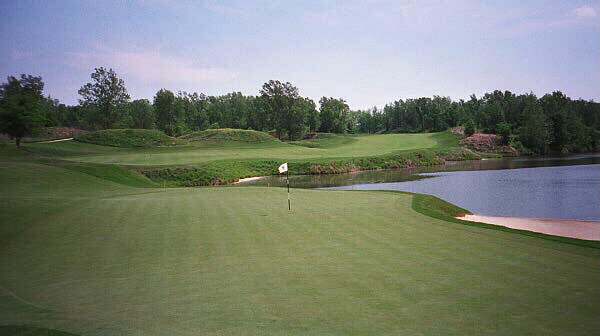
Looking back up the 15th hole, the slope of the fairway is what will keep even the best golfer honest.
Seventeenth hole, 430 yards; A hole that combines quite successfully two different ‘looks’ and themes, the 17th offers an heroic tee shot daring the player to come as close to the water on the right as possible to afford himself a shorter approach and the better angle. The green is reminiscent of the 17th at Royal Melbourne (West) with its sprawling bunkers on the right and a ‘safe’ area to the left. The authors often think of this approach when critics mistakenly categorize Victoria National as an ‘all or nothing’ target course with little strategy.
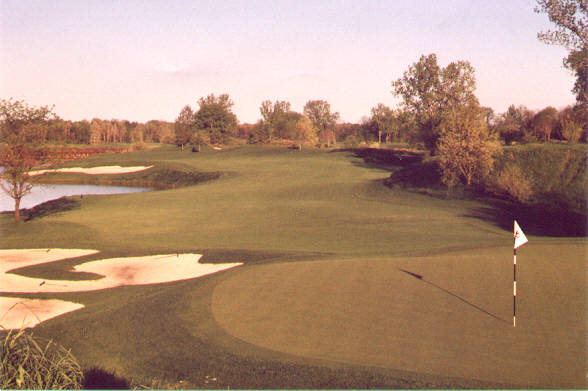
Looking back down the twisting 17th, the Tiger will try and carry the lake off the tee and be left with only a short iron in while the weaker golfer can lay back in the crook of the dogleg and be left with a long iron approach.
Eighteenth hole, 405 yards; Though similar from the tee with the 17th in that the water is on the right, the holes play entirely different. In the case of the 18th, the greenside bunker is on the left, and if the golfergoes toofar through the dogleg, he is faced with a miserable approach angle over the left greenside bunker and back toward the lake.
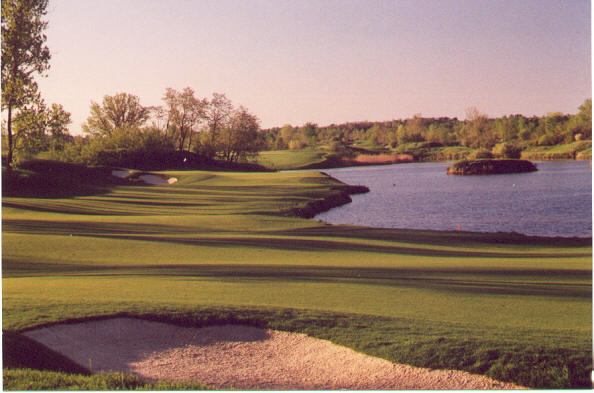
The challenging dogleg right 18th provides a stern finish. Should the golfer lay back off the tee so that he doesn’t have to carry the left greenside bunker?
Why does Victoria National work so well? First, it occupies an arresting site that allowed for an interesting design without depending on much earth-moving for its features. Second, the architect had the job that all designers hope and pray for – to build a course for a private club and have to answer to only one man. Third, the architect spent plenty of time on site with a direct result being the number of interesting playing angles. Rarely do such factors all come together. They did for Fred Jones and Pete Dye at The Golf Club, but this is the exception rather than the rule.
In the end, Fazio and Friedman created a course that reflected its environment – rough around the edges. With only 27 acres of fairway, the course requires good golf, and a low round is immensely satisfying. This is only appropriate, as the former residents of the site did not come there for fun – they had a job to do, just as the player who steps on the first tee has.

